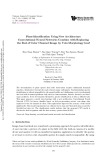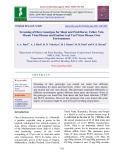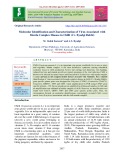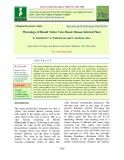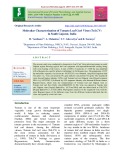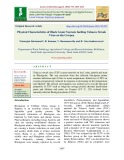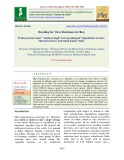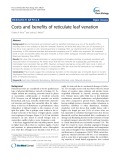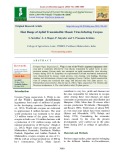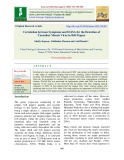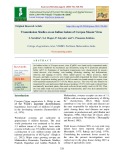
Leaf veins
-
This model experimented on collector leaves data set Flavia leaf data set and the Swedish leaf data set. The classication results indicate that the proposed CNN model is effective for leaf recognition with the best accuracy greater than 98.22%.
 12p
12p  redemption
redemption
 20-12-2021
20-12-2021
 11
11
 0
0
 Download
Download
-
Leaf length and width could be a functioning relationship naturally as plant designs. Single-vein leaves have the simplest symmetrical distribution and structural design, which means that fast-growing single-vein species could interpret the scheme more efficiently.
 11p
11p  vijichea2711
vijichea2711
 28-05-2021
28-05-2021
 9
9
 1
1
 Download
Download
-
Screening of okra genotypes was carried out under four different environments for shoot and fruit borer, yellow vein mosaic virus disease and enation leaf curl virus disease. The genotypes responded differently to different environments against different insect-pests and diseases. None of the genotype was found free from shoot and fruit borer infection, YVMV and ELCV incidence. However the genotypes that were found with some degree of resistance might be used for future breeding programmes.
 11p
11p  trinhthamhodang11
trinhthamhodang11
 27-04-2021
27-04-2021
 12
12
 1
1
 Download
Download
-
Chilli (Capsicum annuum L.) is an important crop grown worldwide for its use as spice and vegetable. Murda complex is the most destructive syndrome causing substantial economic losses in chilli production. Severe leaf curling, leaf distortion, vein banding, reduced leaf size and stunted growth are typical symptoms of the viral infection. Chilli is known to be infected by many viruses and association of Geminivirus with murda complex is under question as the complex disease doesn’t associate with whiteflies.
 8p
8p  nguaconbaynhay10
nguaconbaynhay10
 22-01-2021
22-01-2021
 12
12
 2
2
 Download
Download
-
The major production constraint for okra is yellow vein mosaic disease, causing losses with regard to the quality and as well as the yield. This is a viral disease occurring on bhendi. Yellowing of the entire network of veins in the leaf blade is the characteristic symptom. In severe infections, the younger leaves turn yellow to become entirely chlorotic and the plant is highly stunted.
 5p
5p  trinhthamhodang9
trinhthamhodang9
 16-12-2020
16-12-2020
 13
13
 2
2
 Download
Download
-
The present study was conducted to characterize Leaf Curl Virus infecting tomato in south Gujarat region showing typical leaf curl symptom with upward/downward curling along with vein clearing of the leaves. A part of DNA-A molecule of ~1200 bp was amplified with a Begomovirus specific primers confirming it to be Begomovirus. On sequencing, a 1125 bp nucleotide sequence (Accession no- KU921251) was obtained. Amplified fragment had two genes viz., virus coat protein (V1) gene and pre coat protein (V2) gene.
 9p
9p  chauchaungayxua6
chauchaungayxua6
 26-06-2020
26-06-2020
 11
11
 0
0
 Download
Download
-
Turcicum leaf blight (TLB) or Northern Corn Leaf Blight (NCLB) is a ubiquitous foliar disease of corn (maize) caused by Exserohilum turcicum, the anamorph of the ascomycete Setosphaeria. The TLB fungus survives through the winter on infected maize residue at the soil surface. As temperatures rise in the spring and early summer, the fungus produces spores on residue, and then the spores are splashed or wind-blown onto leaves of the new maize crop. Infection occurs during periods of moderate (64° to 81°F), wet and humid weather.
 7p
7p  chauchaungayxua6
chauchaungayxua6
 26-06-2020
26-06-2020
 17
17
 1
1
 Download
Download
-
Cyantraniliprole 10% OD at 90 g a.i.ha-1 was significantly effective when sprayed twice at 15 days interval, minimized the sucking pests population and increased cotton kapas yield. Cyantraniliprole 10% OD treatments at 90, 180 and 320 g a.i. ha-1 concentrations had not caused any phytotoxic effects like injury to leaf tip, leaf surface, wilting, vein clearing, necrosis, epinasty and hyponasty. Cyantraniliprole 10% (w/v) OD showed the least effect against the spiders.
 13p
13p  nguaconbaynhay6
nguaconbaynhay6
 24-06-2020
24-06-2020
 9
9
 1
1
 Download
Download
-
Scab is the most serious disease of apple, particularly in years with cool wet springs and summers. Symptoms occur on leaf blade, fruit, petioles, sepals, blossoms, young shoots, and bud scales. The lesion increase in size as olive green colored which become progressively darker brown raised and velvety in appearance due to the abundant production of conidiophores and conidia.
 12p
12p  gaocaolon5
gaocaolon5
 14-06-2020
14-06-2020
 6
6
 1
1
 Download
Download
-
Tobacco streak virus (TSV) causes necrosis on leaf, veins, petiole and stem in Blackgram. The sap extracted from the infected blackgram plants remains infectious upto 24 hrs at room temperature. Infectivity of TSV on cowpea progressively reduced in response to increasing in the temperature and dilution. The present investigation was carried out to test the physical properties of TSV such as longevity storage period, thermal inactivation point and dilution end point on Cowpea (CV C- 125) isolated from naturally infected Blackgram plants (CO-8).
 8p
8p  trinhthamhodang1213
trinhthamhodang1213
 02-06-2020
02-06-2020
 12
12
 1
1
 Download
Download
-
Okra [Abelmoschus esculentus (L.) Moench], is an important crop which is widely cultivated in different parts of the world mostly for human consumption and also for industrial use as fibre. The okra production in India, is hindered by occurrence viral diseases, like Yellow Vein Mosaic Virus (YVMV) disease and Okra Enation Leaf Curl Virus (OELCV) disease, spread by an insect vector, namely whitefly (Bemisia tabaci Gen), which affect okra production in terms of yield and fruit quality as well.
 13p
13p  caygaocaolon5
caygaocaolon5
 27-05-2020
27-05-2020
 13
13
 1
1
 Download
Download
-
Recent theoretical and empirical work has identified redundancy as one of the benefits of the reticulate form in the evolution of leaf vein networks. However, we know little about the costs of redundancy or how those costs depend on vein network geometry or topology.
 8p
8p  viminato2711
viminato2711
 22-05-2020
22-05-2020
 13
13
 1
1
 Download
Download
-
Cowpea (Vigna Unguiculata L. Walp.) is one of the World’s important leguminous food crop and is commonly affected by viral disease transmitted by aphid vector in nonpersistent manner. Present study was attempted on aphid transmissible virus infecting cowpea, during 2015-16. Symptoms on experimental field and mechanical transmission were characterized by mosaic, veinal necrosis, vein clearing, vein banding, blistering, stunting, leaf deformations, chlorosis and cupping of leaves. Further, Aphid transmissible virus of cowpea has restricted host range and infected only four plant species viz.
 6p
6p  nguaconbaynhay5
nguaconbaynhay5
 11-05-2020
11-05-2020
 10
10
 0
0
 Download
Download
-
Field surveys were conducted for collection of CMV virus isolates in bell pepper depicting a wide range of symptoms ranging from mosaic, mottling, yellow discoloration, vein clearing, leaf deformation, shoe stringing or leaf narrowing, stunted growth to reduced fruit size. In an attempt to correlate the symptoms with virus concentration in different isolates, DAS-ELISA was performed on symptomatic plants and CMV was detected in majority of the isolates. It was observed that the plants with shoe stringing (typical symptom of CMV in bell pepper) had the highest O.D.
 7p
7p  chauchaungayxua5
chauchaungayxua5
 05-05-2020
05-05-2020
 11
11
 2
2
 Download
Download
-
An Indian isolate of Cowpea mosaic virus (CpMV) was found easily transmitted under glass house conditions by mechanical sap inoculation, using 0.1% potassium phosphate buffer (pH 7.4). Symptoms of mechanical transmission were characterized by mosaic, veinal necrosis, vein clearing, vein banding, blistering, stunting, leaf deformations, chlorosis and cupping of leaves.
 7p
7p  chauchaungayxua5
chauchaungayxua5
 05-05-2020
05-05-2020
 9
9
 2
2
 Download
Download
-
The aim of this study was to establish the morphological basis for the classification of major cassava cultivars (Manihot esculenta Crantz) planted in Vietnam. Twenty typical descriptors were observed in various specific growth stages. Four traits related to mature leaves and two traits related to leaf veins were detected in cassava plants after the 4-month stage.
 8p
8p  vitheseus2711
vitheseus2711
 28-10-2019
28-10-2019
 7
7
 1
1
 Download
Download
CHỦ ĐỀ BẠN MUỐN TÌM








